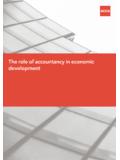Transcription of PROTECTION OF ‘CRITICAL INFRASTRUCTURE’ …
1 Investment Division, Directorate for Financial and Enterprise Affairs Organisation for Economic Co-operation and Development 2 rue Andr -Pascal, Paris 75116, France PROTECTION OF critical INFRASTRUCTURE AND THE ROLE OF INVESTMENT POLICIES RELATING TO NATIONAL SECURITY May 2008 This report is published under the OECD Secretariat's responsibility and was prepared by Kathryn Gordon (Senior Economist, OECD) and Maeve Dion (George Mason University Law School) in support of discussions at the OECD freedom of investment roundtables. 2 Executive summary critical infrastructure has received special attention in recent changes to national investment policies in some countries.
2 This paper reviews the role of investment policies in broader national strategies for protecting critical infrastructure. The key findings are: Many countries have national plans or strategies for protecting critical infrastructure. These strategies generally define critical infrastructure as physical or intangible assets whose destruction or disruption would seriously undermine public safety, social order and the fulfilment of key government responsibilities. Such damage would generally be catastrophic and far-reaching. Sources of critical infrastructure risk could be natural ( earthquakes or floods) or man-made ( terrorism, sabotage).
3 The national strategies studied generally adopt a risk management approach to critical infrastructure PROTECTION . This approach helps governments to identify key security assets, assess risks and establish strategies and priorities for mitigating these risks. Generally, the risk management strategy involves measures to be taken in the following areas: prevention, preparedness, response and recovery. The plans seek to improve coordination among relevant agencies and with private sector operators of critical infrastructure facilities in order to manage risks associated with critical infrastructure.
4 Information provided by notifications made under the OECD National Treatment Instrument shows that all adhering countries have one or more investment measures that address infrastructure. These are of three types: 1) blanket restrictions; 2) sectoral licensing or contracting; 3) trans-sectoral measures such as investment review procedures. For some countries, these discriminatory investment policies are extremely limited in scope ( they concern cabotage or investments in vessels flying the national flag), whereas for others the sectoral coverage of restrictive policies is broad.
5 The critical infrastructure policies reviewed here attempt to coordinate the role of private operators of such infrastructure - be they domestic or foreign - in broader national efforts to protect critical infrastructure. However, the role assigned to investment policies in critical infrastructure PROTECTION varies. Many countries perceive the value added by investment policy measures, relative to other policies ( defense, law enforcement, sectoral), as negligible and accordingly assign little or no role to investment policy. Others note that, while their critical infrastructure PROTECTION policy adopts a broad approach to risk, investment policy is used to address only a narrow range of these risks - those related to national security - and only as a measure of last resort, only if other, less restrictive and non-discriminatory, measures cannot adequately mitigate the identified risks.
6 3 I. Introduction Since early 2006, the Freedom of Investment (FOI) project has provided a forum for discussing how governments can reconcile their duty to safeguard the essential security interests of their people with the need to protect and expand an open international investment system. The project includes in-depth policy discussions of selected national security topics. Recent policy changes in OECD and non-member countries show that critical infrastructure has gained prominence as a concern for essential security interests. Drawing on notifications made under OECD investment instruments and on other publicly available information, this note presents a factual survey of governments general strategies for protecting critical infrastructure and of the role that investment policy plays in these strategies.
7 This note contains the following sections: Section II. Definitions of critical Infrastructure Section III. General policy frameworks for the PROTECTION of critical infrastructure Section IV. Review of foreign investment policies in infrastructure sectors Section V. The contribution of investment policy to critical infrastructure PROTECTION II. Definitions of critical Infrastructure This section reviews definitions used by governments in the context of national or regional infrastructure PROTECTION programmes. Table 1 shows the definitions of critical infrastructure used in 6 published critical infrastructure PROTECTION plans or strategies.
8 This review of definitions considers separately the two words - critical and infrastructure - and then looks at the sectoral coverage of critical infrastructure PROTECTION programmes: critical : In most countries definitions, the word critical refers to infrastructure that provides an essential support for economic and social well-being, for public safety and for the functioning of key government responsibilities. For example, Canada s definition of criticality involves serious impact on the health, safety, security, or economic well-being of Canadians or the effective functioning of governments in Canada.
9 Germany refers to significant disruptions to public order or other dramatic consequences. The Netherlands critical infrastructure policy refers to infrastructure whose disruption would cause major social disturbance , tremendous loss of life and economic damage . Thus, the word critical refers to infrastructure which, if disabled or destroyed, would result in catastrophic and far-reaching damage. Infrastructure: The definitions of infrastructure used in official descriptions of critical infrastructure tend to be broad. All 6 governments in Table 1 refer to physical infrastructure.
10 Most also include intangible assets and/or to production or communications networks. Australia, for example, refers to physical facilities, supply chains, information technologies, and communications networks. Canada refers to physical and information technology facilities, networks, services and assets . The United Kingdom refers to assets, services and systems . Sectoral coverage: Table 2 shows a sample of the sectoral lists identified as being of concern for critical infrastructure PROTECTION in six national programmes and by the European Commission. These lists show that most governments adopt a broad sectoral perspective on critical infrastructure they include sectors that account for substantial portions of national income and 4 employment1.
















